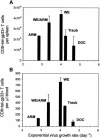Underwhelming the immune response: effect of slow virus growth on CD8+-T-lymphocyte responses
- PMID: 14963121
- PMCID: PMC369240
- DOI: 10.1128/jvi.78.5.2247-2254.2004
Underwhelming the immune response: effect of slow virus growth on CD8+-T-lymphocyte responses
Erratum in
- J Virol. 2004 Jun;78(11):6079
Abstract
The speed of virus replication has typically been seen as an advantage for a virus in overcoming the ability of the immune system to control its population growth. Under some circumstances, the converse may also be true: more slowly replicating viruses may evoke weaker cellular immune responses and therefore enhance their likelihood of persistence. Using the model of lymphocytic choriomeningitis virus (LCMV) infection in mice, we provide evidence that slowly replicating strains induce weaker cytotoxic-T-lymphocyte (CTL) responses than a more rapidly replicating strain. Conceptually, we show a "bell-shaped" relationship between the LCMV growth rate and the peak CTL response. Quantitative analysis of human hepatitis C virus infections suggests that a reduction in virus growth rate between patients during the incubation period is associated with a spectrum of disease outcomes, from fulminant hepatitis at the highest rate of viral replication through acute resolving to chronic persistence at the lowest rate. A mathematical model for virus-CTL population dynamics (analogous to predator [CTL]-prey [virus] interactions) is applied in the clinical data-driven analysis of acute hepatitis B virus infection. The speed of viral replication, through its stimulus of host CTL responses, represents an important factor influencing the pathogenesis and duration of virus persistence within the human host. Viruses with lower growth rates may persist in the host because they "sneak through" immune surveillance.
Figures





References
-
- Altman, J. D., P. A. H. Moss, P. J. R. Goulder, D. H. Barouch, M. G. McHeyzer-Williams, J. I. Bell, A. J. McMichael, and M. M. Davis. 1996. Phenotypic analysis of antigen-specific T lymphocytes. Science 274:94-96. - PubMed
-
- Battegay, M., S. Cooper, A. Althage, J. Banziger, H. Hengartner, and R. M. Zinkernagel. 1991. Quantification of lymphocytic choriomeningitis virus with an immunological focus assay in 24- or 96-well plates. J. Virol. Methods 33:191-198. - PubMed
-
- Bell, G. I. 1973. Predator-prey equations simulating an immune response. Math. Biosci. 16:291-314.
Publication types
MeSH terms
LinkOut - more resources
Full Text Sources
Research Materials

